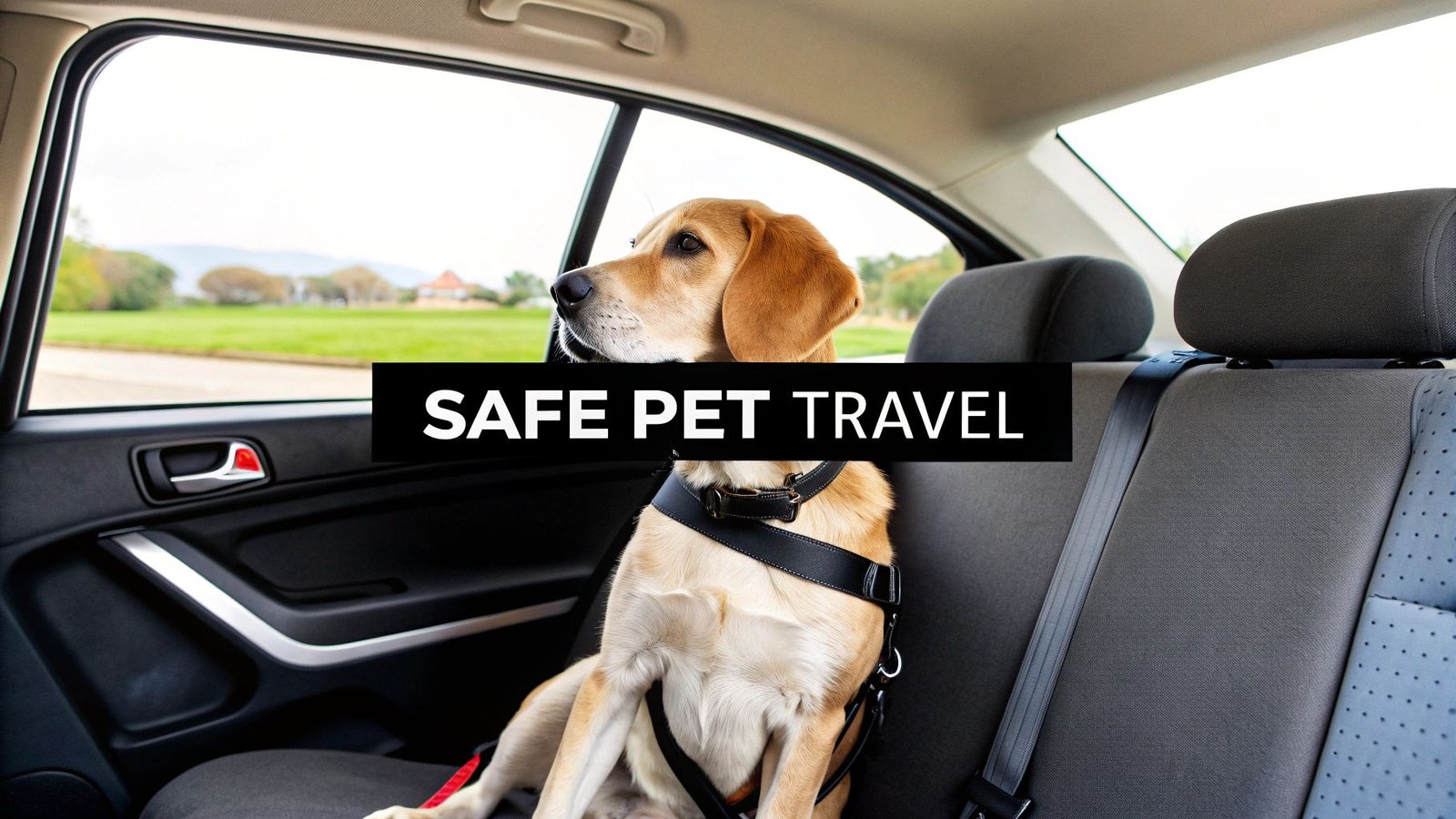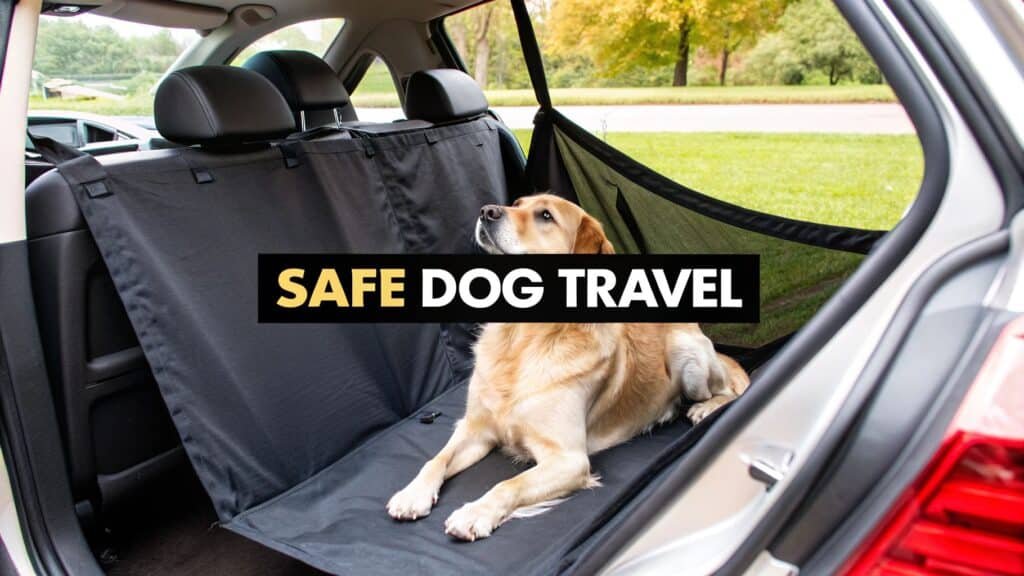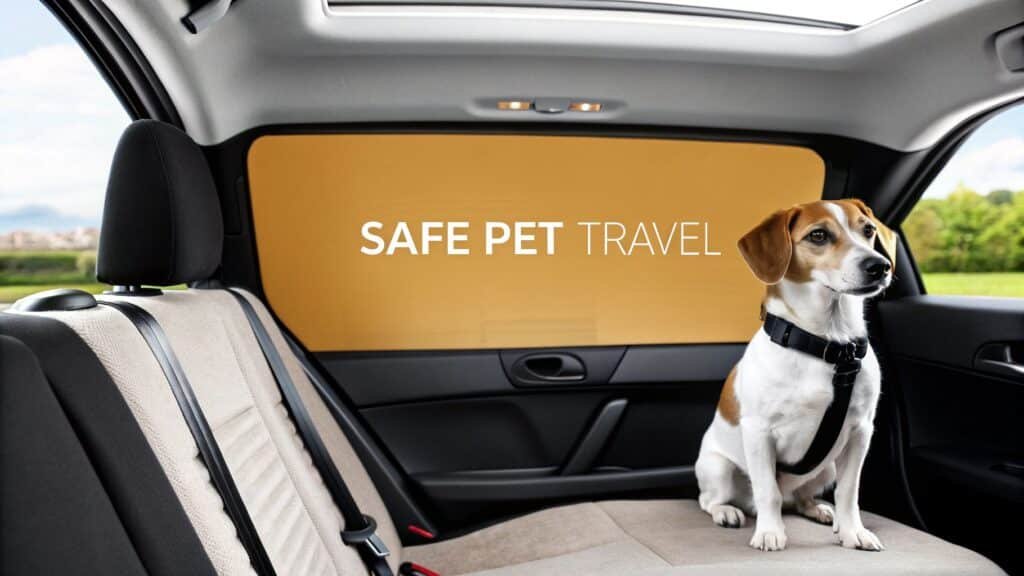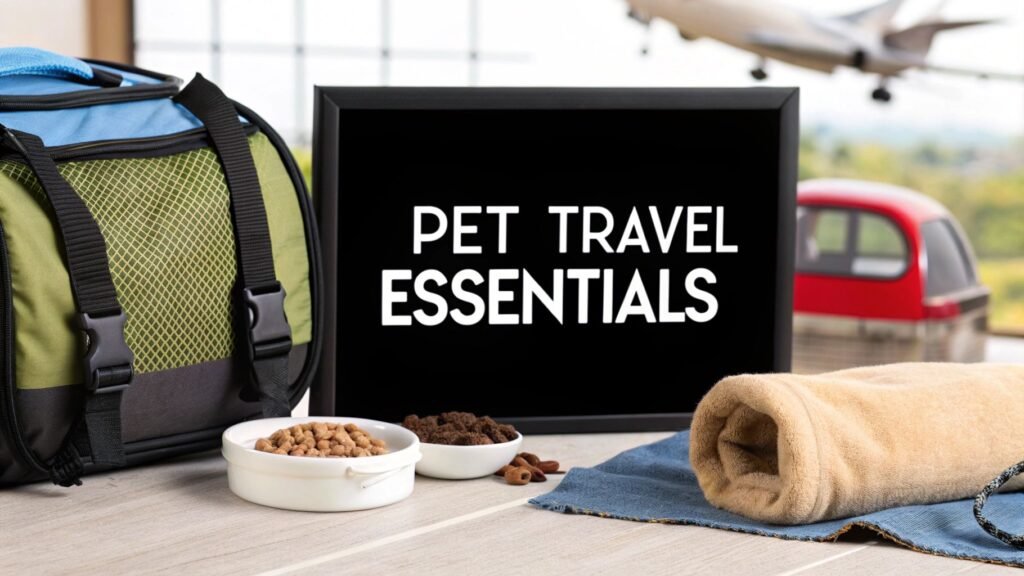Choosing the Best Pet Seat Belt for Car Travel

Think of a pet seat belt as more than just an accessory—it’s a crucial piece of safety gear. It’s essentially a specially designed harness that integrates with your car’s own seatbelt system, keeping your dog secure while you’re on the move. Making this a standard part of your travel routine is one of the smartest things you can do as a pet owner.
Why You Absolutely Need a Pet Seat Belt

We’ve all had to slam on the brakes unexpectedly. When that happens, anything not tied down goes flying. Your dog is no exception.
The physics here are genuinely terrifying. In a crash at just 30 mph, a 60-pound dog can fly forward with the force of about 2,700 pounds. That’s a catastrophic risk, not just for your best friend, but for everyone else in the car. A proper pet seat belt is designed to prevent that exact scenario.
It’s All About Dual Protection
A good restraint system isn’t just about surviving a crash; it’s also about preventing one from happening in the first place. It provides two critical layers of safety that work together.
- Protecting Your Pet: First and foremost, it keeps your dog from being thrown around the cabin or, worse, ejected from the car during an accident. This drastically reduces their risk of serious injury or death.
- Protecting You and Your Passengers: It also eliminates a huge driver distraction. A secured dog can’t suddenly jump into the front seat, block your view, or get tangled in your feet while you’re trying to drive.
When your pet is secure, you can focus 100% on the road. It’s this dual benefit—preventing distractions and providing crash protection—that makes a pet seat belt non-negotiable.
A Growing Awareness of Pet Safety in Cars
This shift toward securing our pets in the car reflects how much our relationship with them has changed. We see them as family, and we want to protect them like family.
It’s no surprise that the demand for these safety products has shot up. The global market is growing fast, with projections showing it will expand at a Compound Annual Growth Rate of 7-8% through 2033. This growth is all about pet owners becoming more aware and wanting the best for their animals. You can find more insights on the pet safety market to see just how big this trend is.
Ultimately, it all comes down to a simple truth: buckling up your pet is just as important as buckling up yourself. It’s the key to peace of mind on every single trip.
Decoding the Different Types of Pet Restraints
Walking into a pet store and seeing a wall of car restraints can be a bit much. But don’t worry—it’s not as complicated as it looks. The first step is just getting to know the main players. The best pet seat belt for a tiny, quiet Chihuahua is a world away from what a rowdy Golden Retriever needs.
Think of it like picking out the right shoes. You wouldn’t wear flip-flops on a mountain trail, right? The right restraint comes down to your dog’s size, personality, and the type of driving you typically do.
Each design works a little differently, but they all share the same goals: keeping your pet safe, keeping you focused on the road, and providing real protection if the worst happens.
Let’s break down the most common options you’ll find.
Harness and Tether Systems
This is what most people picture when they hear “dog seat belt.” It’s a simple but effective system: a sturdy harness goes around your dog’s chest, and a short tether connects that harness to the car’s seat belt buckle. Simple as that.
The magic is in how it distributes force. If you have to slam on the brakes, a good harness spreads that sudden jolt across the strongest parts of your dog’s body—their chest and shoulders. It’s a huge step up from clipping a tether to a collar, which is incredibly dangerous and can cause severe neck injuries. The best ones are crash-tested and built with the same kind of tough materials you’d find in your own seat belt.
This is a go-to choice for a reason—it’s versatile and fits almost any breed. To see what quality gear looks like, you can browse a curated collection of well-made collars, leashes, and harnesses designed with both safety and comfort in mind.
Zipline-Style Restraints
Picture a clothesline stretched across your back seat—that’s pretty much how a zipline restraint works. A strap runs between two anchor points in your car, like the grab handles above the doors. A separate tether clips from your dog’s harness onto that line, giving them the freedom to roam from window to window.
This is a great option for dogs that get a little antsy and need to shift around to get comfortable. They can sit, stand, and lie down without getting tangled. But that freedom comes at a price.
- Pro: Gives your dog more room to move around, which can reduce anxiety on long trips.
- Con: The extra slack means that in a collision, your dog could build up more momentum before the restraint catches, which could lead to a harder impact.
This style is often best for calmer dogs on road trips where a little extra comfort goes a long way. For high-impact safety, though, a more restrictive system is usually better.
A critical takeaway: No matter the style, a restraint is only as safe as the harness it’s attached to. Never connect any car restraint system directly to your pet’s collar.
Secured Travel Crates and Carriers
For many pets, especially smaller dogs and cats, the safest place to be is inside a secured travel crate. I’m not talking about a flimsy plastic carrier, but a durable, often crash-tested crate that’s buckled tightly into your car with a seat belt.
Think of the crate as a protective shell. In an accident, it absorbs the initial force, and your pet is safely contained inside instead of being thrown around the cabin. This is also a fantastic solution for nervous travelers who might try to chew through or escape a harness.
The keyword here is “secured.” A crate sliding around in the back is just as dangerous as an unrestrained pet. It needs to be strapped in so it can’t move, slide, or tumble. When done right, it’s an all-in-one solution for containment, comfort, and serious safety.
Comparing Pet Seat Belt Styles
With all these options, which one makes the most sense for you and your furry co-pilot? This quick comparison breaks down the main restraint systems to help you weigh the pros and cons at a glance.
| Restraint Type | Best For | Key Benefit | Primary Drawback |
|---|---|---|---|
| Harness & Tether | Most dogs of all sizes | Excellent crash protection & force distribution | Can feel restrictive for some dogs |
| Zipline Restraint | Calm dogs on long trips | Allows more freedom of movement | Less protection due to extra slack |
| Secured Crate | Small dogs, cats & anxious pets | Maximum containment & impact absorption | Takes up significant backseat space |
Ultimately, the best choice is the one that fits your pet’s needs and your vehicle securely. Any of these options is a massive improvement over no restraint at all, giving you peace of mind and keeping everyone in the car safer on the road.
How to Select the Perfect Pet Seat Belt

Picking out the right pet seat belt is a lot like choosing a car seat for a child. You’re not just looking for something that “fits”—you’re investing in a piece of safety equipment that has to perform when it matters most. With a sea of options out there, it’s easy to get lost. The trick is to focus on a few key details that separate the real deal from the knock-offs.
Think of it as a safety audit for your furry co-pilot. You’ll be looking at the materials, checking the safety claims, and making sure it’s a perfect fit for your dog and your car. After all, a flimsy restraint offers a false sense of security, which is almost as dangerous as having no restraint at all.
Material Quality and Construction
First things first, get your hands on the product and really examine what it’s made of. A safety restraint is only as strong as its weakest component, so everything from the straps to the clips needs to be top-notch. Flimsy materials will shred under the incredible forces of a collision.
You want to see harnesses made from automotive-grade webbing—the same stuff used in our own seat belts. It should feel thick and sturdy, not thin and stretchy. The hardware is just as critical.
- Buckles and Clasps: Look for solid metal hardware. Plastic can become brittle with temperature changes and might shatter under the intense pressure of an accident.
- Stitching: Pay close attention to the stitching at stress points. You want to see reinforced patterns, like box stitching, which is a clear sign of quality construction built to handle sudden, powerful jolts.
A high-quality pet seat belt is an investment. Its materials and construction are the bedrock of its ability to protect your pet in a crash.
Understanding Crash Test Certifications
This is probably the single most important factor. Lots of products have “safety tested” or “crash-proof” slapped on the packaging, but these phrases can be empty marketing buzzwords without real proof. The gold standard to look for is independent, third-party crash testing.
The Center for Pet Safety (CPS) is a non-profit that does this kind of rigorous, unbiased testing. They use crash-test dog dummies and simulate real-world accidents, much like the testing done for children’s car seats. A CPS certification is a genuine seal of approval, meaning the product has been proven to hold up under extreme stress.
When a brand claims its product is crash-tested, dig a little deeper. A truly certified product will wear that badge proudly. Choosing one means you’re trusting proven performance, not just clever advertising.
Getting the Perfect Fit and Sizing
A harness that’s too loose is a huge safety hazard. In an accident, it lets your dog build up dangerous momentum before the tether catches, which dramatically increases the impact forces. It also means a panicked dog could easily wiggle free and become a distraction.
To get the fit right, you have to measure your pet before you buy. Don’t just guess based on weight, because two dogs of the same weight can have completely different builds.
- Measure the Chest Girth: Grab a soft measuring tape and wrap it around the widest part of your dog’s chest, which is usually right behind their front legs.
- Compare with Sizing Charts: Use that number and match it to the manufacturer’s sizing guide. Each brand is a little different.
- Apply the Two-Finger Rule: After you’ve got the harness, adjust the straps so you can just barely slip two fingers between the harness and your dog’s body. This keeps them secure without being uncomfortably tight.
Vehicle Compatibility and Your Pet’s Comfort
Lastly, think about how the seat belt will work in your specific car and for your specific dog. Most tethers click right into a standard seat belt buckle, but it never hurts to double-check. And don’t forget about your dog’s comfort, especially if you take long road trips.
A good harness should let your dog sit, stand, and lie down without getting tangled up. Look for a wide, padded chest plate, which helps distribute pressure evenly across their body and prevents painful chafing.
While safety comes first, a comfortable dog is a happy traveler, and that makes the journey better for everyone. This growing awareness is why the global dog car restraints market, valued at USD 600 million in 2023, is expanding so quickly. North America is leading the charge, with a market projected to hit USD 650 million by 2033, thanks to high pet adoption rates and a strong focus on safety. You can learn more about these dog car seat market trends to see the full picture.
By taking the time to check these key areas, you can choose a pet seat belt that gives you genuine peace of mind on every drive.
Mastering Correct Installation and Use
Having the best pet seat belt on the market is a great start, but that’s only half the battle. Its real life-saving power is only unlocked when it’s installed correctly and used every single time. Think of it like a parachute—it’s an incredible piece of safety gear, but it’s completely useless unless you know how to put it on and use it properly. A loose strap or a flimsy connection point can turn a top-rated safety harness into a real hazard.
The good news is, getting it right isn’t complicated. By following a few simple steps every time you head out, you can make sure your dog is not just secure, but also comfortable. This simple routine can transform car rides from a source of stress into a safe, shared experience for you both.
Achieving the Perfect Harness Fit
A snug, well-adjusted harness is the cornerstone of a safe car ride. If it’s too loose, your dog could slip out in a panic or, worse, build up dangerous momentum in a collision before the restraint even engages. On the other hand, a harness that’s too tight will chafe, restrict their breathing, and just make them miserable.
You’re aiming for a secure fit that feels like a firm, reassuring hug. Here’s how to dial it in perfectly:
- Loosen All Straps: Before you even put the harness on your dog, loosen all the adjustable straps. This gives you a clean slate and makes it much easier to position correctly from the get-go.
- Position and Secure: Slip the harness over your dog. Make sure the padded chest plate sits squarely on their chest and the back attachment point is centered nicely on their back. Then, fasten all the buckles.
- Adjust for a Snug Fit: Go through and tighten each strap one by one until the harness is secure. The best way to check this is with the “two-finger rule”—you should be able to slide two fingers comfortably between the harness and your dog’s body at any point.
- Final Check: Let your dog walk around for a minute. Watch for any signs of rubbing or restricted movement. A properly fitted harness won’t get in the way of their natural stride.
For dogs with unique body shapes, a harness with multiple adjustment points is non-negotiable. A great option is a harness built for both security and adaptability, like a versatile tactical dog harness that can be fine-tuned for a truly precise fit.
Connecting the Tether to Your Vehicle
Once the harness fits like a glove, the next step is tethering it to the car. The length of that tether is absolutely critical. It needs to be short enough to keep your dog from flying into the front seat or hitting the side windows during a sudden stop. At the same time, it must be long enough for them to comfortably sit, stand, and lie down.
Critical Safety Rule: Always attach the tether to the harness, NEVER to your dog’s collar. In an accident, connecting to a collar can cause devastating neck, throat, or spinal injuries.
There are two main ways to secure the tether in your car:
- Seat Belt Buckle Attachment: Most tethers feature a universal clip that clicks right into your car’s seat belt buckle. It’s a fast, straightforward, and reliable method.
- Seat Belt Thread-Through: Some crash-tested systems require you to loop the car’s actual seat belt through designated loops on the back of the harness before buckling. This approach often creates an incredibly secure three-point restraint.
Helping Your Pet Adapt
For some dogs, a new harness and restraint can feel pretty strange, even a little confining. The trick to a smooth transition is simply patience and plenty of positive reinforcement. Start by introducing the harness at home. Let your dog wear it for a few minutes at a time while you give them treats and praise.
Next, have them wear the harness while just sitting in a parked car. Once they’re cool with that, take a few short, slow trips around the block. Gradually make the trips longer as they get used to the feeling of being safely buckled in. If you make the pet seat belt part of a fun routine—like a drive to the dog park—they’ll quickly learn to associate it with good things.
The Real-World Benefits of Buckling Up Your Pet

Thinking about a pet seat belt as just a way to keep your dog in the back seat is missing the bigger picture. It’s a genuine safety system, and once you understand the tangible benefits for your pet, for you, and even for your wallet, it becomes clear why a proper restraint is an essential piece of gear.
First and foremost, it’s about protecting your best friend. The physics of a car crash are brutal. In a sudden stop, an unrestrained pet becomes a projectile, subject to incredible forces. A good harness and tether system works just like a person’s seatbelt, spreading that impact across the strongest parts of their body—their chest and shoulders.
That simple function can be the difference between a scary moment and a tragic one. It keeps them from hitting the dashboard, colliding with seats, or worse, being ejected from the car.
It’s About Protecting You, Too
Keeping your dog secure makes the car immensely safer for you and your passengers. We all know distracted driving is a massive cause of accidents, and a loose pet is one of the most unpredictable distractions out there. A dog trying to climb into your lap or getting tangled by the pedals is a nightmare scenario waiting to happen.
A pet seat belt takes that risk right off the table. It keeps your dog in their spot so you can keep your hands on the wheel and your eyes on the road.
There’s also the projectile factor to consider. It sounds awful, but it’s a reality. In a 50 mph crash, even a little 10-pound dog can fly forward with the force of a 500-pound object. That’s a serious danger not just to your pet, but to anyone in their path.
A restrained pet is a predictable pet. That predictability cuts out a huge source of chaos inside the car, making the entire environment safer and letting you focus completely on driving.
Staying on the Right Side of the Law—and Your Budget
Beyond the immediate safety concerns, using a restraint can save you from a world of legal and financial headaches. More and more places are cracking down on distracted driving, and those laws often cover unrestrained pets. Staying compliant means avoiding hefty fines and potential liability if you’re ever in an accident.
Then there’s the financial fallout. Emergency vet bills after a car crash can be astronomical, easily running into the thousands. A reliable pet seat belt is a small, one-time purchase that acts as a powerful insurance policy against those devastating, unexpected costs. For extra comfort, you can pair it with some quality pet beds and mats to make their spot cozy.
It’s no surprise that more owners are catching on. The pet seat belt market is expected to grow steadily, with projections showing an 8% CAGR through 2033 as safety gear becomes standard.
Taking Care of Your Pet Seat Belt
A pet seat belt is just like any other piece of critical safety gear. You wouldn’t ignore worn-out brakes on your car, and you shouldn’t ignore the condition of your dog’s restraint. For it to do its job when it matters most, it needs a little bit of attention from you.
A quick check before each car ride is all it takes. Think of it as a pre-flight check for your four-legged co-pilot—it’s a simple routine that ensures the restraint is strong, reliable, and ready to protect them on every trip.
Your Quick Inspection Checklist
Before you head out, take 30 seconds to give the harness and tether a once-over. It’s amazing what you can spot when you’re looking for it, and catching a small issue now can prevent a catastrophic failure later.
Here’s what to keep an eye on:
- Webbing and Straps: Run your fingers along the straps, checking for any fraying, thinning, or tiny tears. Pay extra attention to the areas around the stitching and adjustment points, as that’s where most of the stress is concentrated.
- Buckles and Clasps: Test every buckle. They should click into place with a satisfying, solid sound and release without a struggle. Look for any cracks or stress marks, especially on plastic parts. A finicky buckle is a red flag.
- Metal Hardware: Give the D-rings, clips, and any other metal bits a quick look. Are there any signs of rust or bending? Corrosion weakens metal, and you don’t want to find that out the hard way.
Keeping It Clean and Strong
A dirty harness isn’t just an eyesore. Over time, all that caked-on mud, grime, and moisture can actually start to break down the fibers in the webbing, making it weaker. Luckily, cleaning is easy, but you have to do it right.
Most pet seat belts can be hand-washed with a bit of mild soap and warm water. Steer clear of harsh detergents or bleach, which can destroy the fabric’s integrity. Once it’s clean, let it air dry completely, but keep it out of direct sunlight or away from heaters that can make the material brittle.
A Critical Rule to Remember: If you’ve been in an accident, you must replace the pet seat belt, even if it looks perfectly fine. The incredible forces from a collision can cause invisible damage—micro-tears and stretching—that completely compromises the restraint. It’s a single-use safety device in a crash, no exceptions.
Questions We Hear All the Time
Even after seeing how crucial they are, most people have a few questions before they’re ready to buy a pet seat belt. That’s perfectly understandable. This is safety equipment for a family member, so you want to get it right. Let’s walk through some of the common questions that pop up.
These are the real-world things people wonder about once they start thinking about buckling up their dog.
What About My Cat? Can I Use a Pet Seat Belt for Them?
This is a great question, but the short answer is no. Most harnesses sold as “pet seat belts” are designed specifically for a dog’s body. A cat’s anatomy is completely different; they’re basically furry little escape artists with a much more flexible skeletal structure. They can easily squirm out of a dog harness, which defeats the whole purpose.
For cats, the gold standard of car safety is a sturdy, well-ventilated carrier that you buckle securely into the backseat. Think of it as their own personal crash-tested pod. It keeps them contained and protected if you have to slam on the brakes. Just make sure you run the seatbelt through the carrier’s straps so it won’t go flying.
Where Is the Absolute Safest Spot for My Pet in the Car?
The backseat. Always the backseat. No exceptions. It’s the same reason we put small children back there: airbags.
An airbag deploys with explosive force. In a crash, even a minor one, that airbag could cause serious or fatal injuries to your pet. Securing your dog in the back with their pet seat belt not only keeps them away from that danger but also prevents them from distracting you by trying to become a lap dog at 65 mph.
The rule is simple and non-negotiable: pets belong in the back. This one habit drastically improves safety for everyone in the car.
Is It Actually Illegal to Have My Dog Unrestrained?
This gets a little complicated because the laws change from one state to the next. Only a handful of states have specific laws mandating that pets must be restrained. However, many more states have broad distracted driving laws, and an unsecured pet climbing all over the car absolutely qualifies as a distraction.
Getting pulled over with a dog in your lap could easily earn you a ticket. Your best bet is to check the website for your state’s DMV to see the local rules. But honestly, legal or not, using a restraint is simply the responsible thing to do.
My Dog Hates Harnesses. How Do I Get Them Used to It?
Patience is everything here, along with a whole lot of treats. If your dog’s never worn a harness, it’s going to feel weird and restrictive to them at first. The trick is to make them think it’s the best thing ever.
- Start Inside: First, just have them wear the harness around the house for a few minutes at a time. Shower them with praise and their favorite snacks.
- Next, the Parked Car: Once they don’t mind wearing it inside, have them wear it while just sitting in the car with the engine off. More treats!
- Baby Steps: Start with a slow trip around the block. Then a little longer. Keep the first few experiences short and sweet.
If you make the harness a clear signal that something fun is about to happen—like a trip to the dog park—they’ll start getting excited the moment they see you pick it up.
At Ur Pet Store, we’re firm believers that every car ride with your pet should be a safe one. We’ve hand-picked a collection of high-quality travel gear designed to give you peace of mind on any adventure. Come see our collection and find the perfect safety solution for your four-legged friend at https://urpetstore.com.




